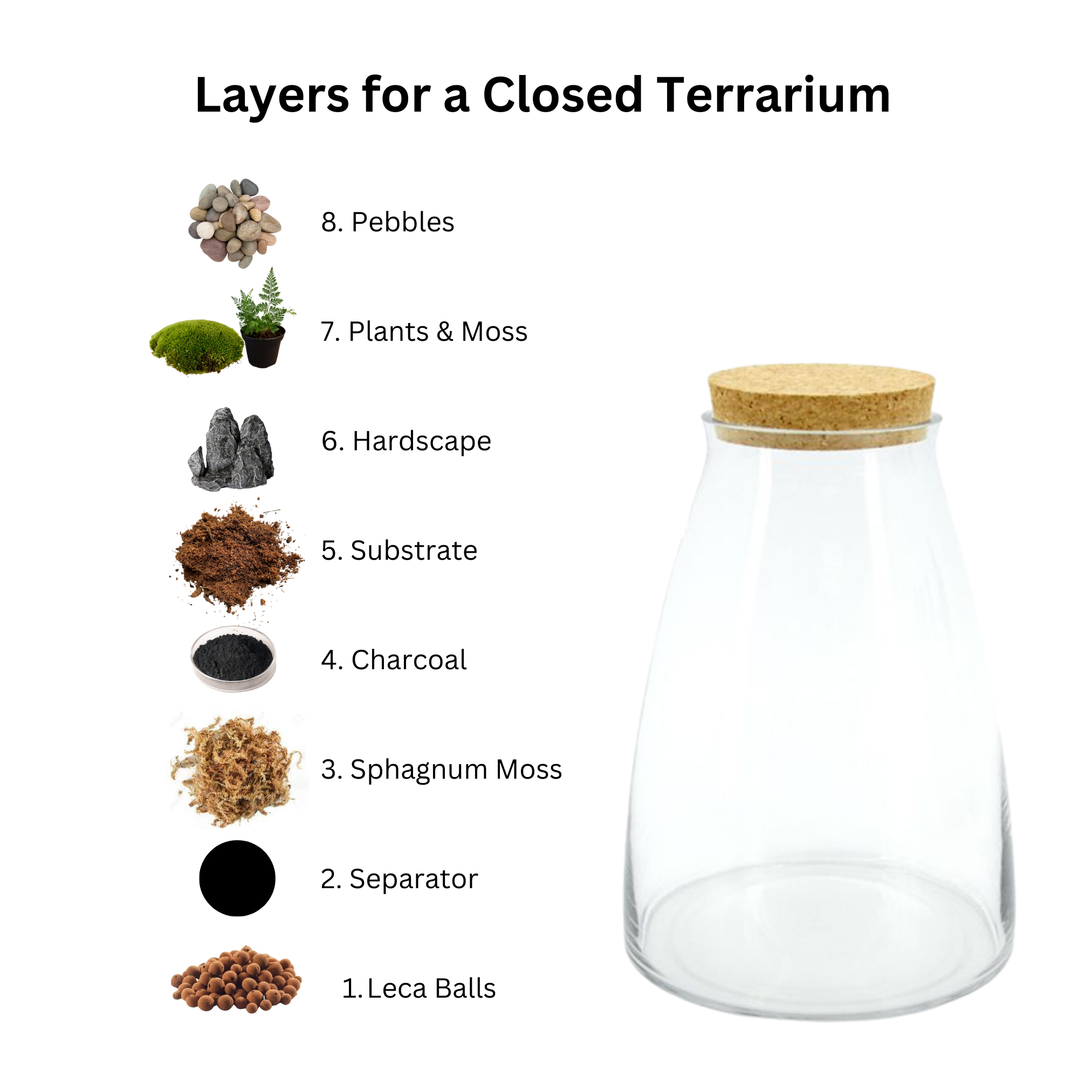Terrarium drainage layers prevent water buildup and root rot. They ensure a healthy environment for plants.
Terrarium drainage layers are essential for maintaining plant health in enclosed environments. These layers consist of materials like gravel or pebbles that create a barrier between water and soil. This setup prevents overwatering, which can lead to root rot and other issues.
Proper drainage also helps in maintaining the right humidity levels inside the terrarium. It’s crucial to choose the right materials and arrange them correctly to ensure effective water drainage. A well-designed drainage layer contributes significantly to the longevity and vitality of your terrarium plants. This simple yet effective step ensures your mini-ecosystem thrives, offering a lush, green display.

Credit: flowerandtwignursery.com.au
Importance Of Drainage In Terrariums
Drainage layers are vital for healthy terrariums. They prevent water from stagnating. Stagnant water can harm plants and their roots. Proper drainage ensures a balanced environment.
Preventing Root Rot
Root rot occurs when roots sit in water for too long. This causes them to decay. A drainage layer keeps excess water away from roots. Healthy roots lead to healthy plants.
Balancing Moisture Levels
Moisture levels must be balanced in terrariums. Too much water can drown plants. Too little water can dry them out. A drainage layer helps maintain the right amount of moisture.
| Problem | Solution |
|---|---|
| Root Rot | Use a drainage layer |
| Overwatering | Drain excess water |
| Dry Soil | Retain some moisture |
Consider using materials like pebbles or charcoal. These materials enhance drainage. They also prevent soil from clogging. Proper drainage makes your terrarium flourish.
- Prevents root rot
- Balances moisture levels
- Supports plant health
- Add pebbles
- Add charcoal
- Cover with soil

Credit: www.reddit.com
Choosing The Right Materials
Creating a terrarium involves selecting the right materials for the drainage layer. This layer is essential for preventing root rot and maintaining plant health. The correct materials ensure your terrarium stays beautiful and thriving.
Gravel And Pebbles
Gravel and pebbles are popular choices for terrarium drainage layers. They help excess water drain away from plant roots. Using these materials creates a solid base for your plants.
- Gravel: Small, coarse stones.
- Pebbles: Larger, smooth rocks.
| Material | Benefits |
|---|---|
| Gravel | Provides excellent drainage. |
| Pebbles | Adds aesthetic value. |
Activated Charcoal
Activated charcoal is another important material for terrarium drainage. It helps keep the terrarium environment fresh. This material absorbs impurities and prevents odors.
- Absorbs toxins: Keeps water clean.
- Prevents mold: Reduces fungal growth.
- Place a thin layer of charcoal above the pebbles.
- Ensure even distribution.
Using these materials together ensures a healthy and attractive terrarium. Choose wisely for the best results.
Layering Techniques
Creating the perfect terrarium starts with proper layering techniques. This ensures a healthy environment for your plants. Let’s dive into the essential steps for setting up the drainage layers.
Base Layer Setup
Start with a solid base layer. Use materials like small rocks, pebbles, or gravel. This layer helps to drain excess water. It prevents root rot and keeps the soil healthy.
Here’s a quick guide to setting up the base layer:
- Choose clean, non-toxic rocks or pebbles.
- Spread a uniform layer at the bottom of the terrarium.
- Ensure the layer is even and covers the entire base.
Proper Layer Depth
The depth of each layer is crucial. It influences the overall health of the terrarium. Follow these guidelines for optimal depth:
| Layer | Recommended Depth |
|---|---|
| Base Layer (Rocks/Pebbles) | 1-2 inches |
| Activated Charcoal | 0.5-1 inch |
| Soil/Substrate | 2-3 inches |
By maintaining the proper depth, you ensure the right balance of moisture and air. This supports plant health and growth.
Remember, each layer serves a distinct purpose. The base layer aids drainage. Activated charcoal filters impurities. The soil provides nutrients. Following these techniques, you can build a thriving terrarium.
Benefits Of Activated Charcoal
Terrariums are a beautiful way to bring nature indoors. A key component is the drainage layer. One popular material for this is activated charcoal. It offers many benefits, making your terrarium healthier.
Odor Control
Activated charcoal helps in controlling odors. It absorbs unpleasant smells. This keeps your terrarium smelling fresh. Your plants and animals will enjoy a better environment.
Toxin Absorption
Activated charcoal is great for absorbing toxins. It traps harmful chemicals. This makes the terrarium safer. Your plants will grow healthier. Your pets will thrive.
Creating A Water Reservoir
Creating a water reservoir in your terrarium is crucial. It helps maintain the right moisture levels. A well-made water reservoir prevents root rot and keeps plants healthy. In this section, we will focus on two main components: Using Mesh Screens and Maintaining Water Levels.
Using Mesh Screens
Mesh screens separate the soil from the water layer. This separation is essential for plant health. Without it, roots may sit in water and rot. Mesh screens come in different materials such as plastic and metal. The choice depends on your terrarium size and type.
Here is a simple way to install a mesh screen:
- Cut the mesh screen to fit the base of your terrarium.
- Place the mesh screen above the drainage layer.
- Ensure the screen covers the entire base.
This setup keeps soil from mixing with the drainage layer. It also allows water to flow freely.
Maintaining Water Levels
Maintaining water levels in your terrarium is vital. Too much water can cause root rot. Too little water can dry out plants. Use a water gauge to monitor levels.
Here is a simple table to help you:
| Water Level | Action |
|---|---|
| Too High | Remove excess water with a syringe. |
| Too Low | Add water using a spray bottle. |
| Just Right | Maintain current water levels. |
Check water levels weekly. Adjust as needed to keep plants happy.
Follow these steps and your terrarium will thrive.
Common Mistakes To Avoid
Creating a terrarium can be a fun and rewarding project. However, there are some common mistakes that can ruin your efforts. Understanding these pitfalls will help you create a thriving terrarium.
Overwatering Issues
Overwatering is one of the most common mistakes in terrarium care. Too much water can lead to root rot and mold growth. Always use a spray bottle to control the amount of water.
Here are some signs of overwatering:
- Yellowing leaves
- Mold on the soil surface
- Water pooling at the bottom
Keep a close eye on the moisture level. Less water is often better than too much.
Inadequate Layering
Inadequate layering can cause drainage problems in your terrarium. A good drainage layer is essential for plant health. It prevents water from stagnating at the roots.
Here is a simple guide to proper terrarium layering:
| Layer | Material | Purpose |
|---|---|---|
| Bottom Layer | Gravel or Pebbles | Drainage |
| Second Layer | Activated Charcoal | Filtration |
| Third Layer | Moss | Barrier |
| Top Layer | Potting Soil | Planting Medium |
Ensure each layer is distinct and well-spread. This will help in preventing root rot and ensuring proper drainage.
Choosing The Right Plants
Creating a terrarium involves picking the right plants. The plants you choose should thrive in the specific environment you create. This means considering factors like moisture, light, and temperature.
Moisture-loving Plants
Some plants love moist environments. These plants thrive in the humid conditions of a terrarium. Here are some great options:
- Ferns: Ferns enjoy damp soil and indirect light.
- Moss: Mosses can grow well in low light and high humidity.
- Fittonia: Also known as nerve plants, they need regular misting.
Moisture-loving plants need a well-draining soil. This prevents root rot and helps them stay healthy.
Drought-tolerant Options
Some plants prefer dry conditions. These plants are perfect for open terrariums. Here are some choices:
- Succulents: Succulents store water in their leaves.
- Cacti: Cacti need very little water and lots of light.
- Air Plants: Air plants absorb moisture from the air.
Drought-tolerant plants need a sandy, well-draining soil. This keeps their roots from getting too wet.
Maintaining Your Terrarium
Keeping your terrarium in top shape requires regular care. This ensures your plants stay healthy and vibrant. Proper maintenance also prevents any unwanted issues like mold or pests.
Regular Monitoring
Check your terrarium daily. Look for signs of overwatering or underwatering. Watch for any changes in your plants’ health. Look for mold or pests. Use a moisture meter if needed. This helps you keep the environment balanced.
Cleaning And Upkeep
Regular cleaning keeps your terrarium looking fresh. Remove dead leaves and debris. This prevents decay and mold growth. Use a small brush to clean the glass. Wipe away any dirt or condensation. This ensures clear visibility.
Check the drainage layer. Make sure it’s not clogged. If the drainage layer is blocked, water can’t flow properly. This can cause root rot. To clean the drainage layer:
- Gently remove the top layers.
- Clean out any debris.
- Reassemble the layers carefully.
Regular upkeep keeps your terrarium thriving. Healthy plants make a beautiful display.

Credit: www.minibotanics.co.nz
Conclusion
Creating a proper drainage layer is crucial for terrarium health. It prevents root rot and promotes plant growth. Use materials like gravel, charcoal, and mesh for effective drainage. A well-drained terrarium ensures a balanced environment, keeping your plants vibrant and thriving.
Invest time in setting up a good drainage layer for lasting results.
